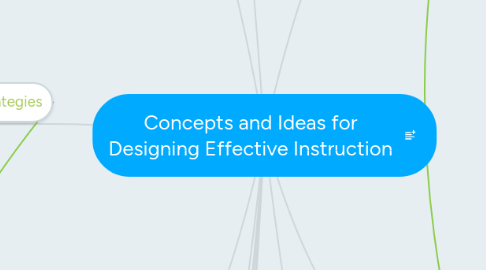
1. Instructional problems
1.1. Instructional Designer
1.2. SME
1.3. Learners
1.4. Instructional Problem
1.5. Objectives
1.6. Methods
1.6.1. ADDIE
1.7. Evaluation
1.7.1. Summative Evaluation
1.7.2. Confirmative Evaluation
1.7.3. Formative Evaluation
1.7.4. Evaluator
1.8. Needs Assessment
1.8.1. Normative Needs
1.8.2. Comparative Needs
1.8.3. Felt Needs
1.8.4. Anticipated Needs
1.8.5. Expressed Needs
1.8.6. Critical Incident Needs
1.9. Goal Analysis
1.9.1. identify an aim
1.9.2. set goals
1.9.3. refine goals
1.9.4. rank goals
1.9.5. refine goals again
1.9.6. make final ranking
1.10. Performance Assessment
2. Learner Characteristics
2.1. Learner Analysis
2.1.1. learner factors
2.2. Contextual Analysis
2.2.1. contextual levels
2.2.1.1. Orienting Context
2.2.1.2. Instructional Context
2.2.1.3. Transfer Context
2.2.2. immediate environmental factors
2.2.3. organisational factors
3. Task Analysis
3.1. Task Analysis
3.1.1. Conducting a task analysis
3.1.1.1. serving as your own SME
3.1.1.2. Techniques from gathering data
3.1.1.2.1. literature research
3.1.1.2.2. interviewing an SME
3.1.1.2.3. Developer modeling
3.2. Topic Analysis
3.3. Content Structures
3.3.1. facts
3.3.2. concepts
3.3.3. principles and rules
3.3.4. procedures
3.3.5. interpersonal skills
3.3.6. attitudes
3.4. Procedural Analysis
3.5. Critical Incident method
4. Instructional Objectives
4.1. Cognitive Domain
4.1.1. Bloom's Taxanomy
4.1.1.1. Evaluating
4.1.1.2. Creating
4.1.1.3. Analyzing
4.1.1.4. Applying
4.1.1.5. Understanding
4.1.1.6. Remembering
4.2. Psychomotor Domain
4.2.1. Dave's Model
4.2.2. Simpson's Model
4.2.3. Harrow's Model
4.3. Affective Domain
4.3.1. Behavioral Learning Theory
4.3.2. Cognitive Dissonance Theory
4.3.3. Affective-Cognitive Consistency
4.3.4. Social Judgement Theory
4.3.5. Social Learning Theory
4.3.6. functional Theories
4.3.7. Krathwohl's Taxanomy
5. Content Sequencing
5.1. Posner and Strike Sequencing Schemes
5.1.1. Learning Related Sequencing
5.1.1.1. 5 Student Learning Concepts
5.1.1.1.1. Identifiable Prerequisites
5.1.1.1.2. Familiarity
5.1.1.1.3. Difficulty
5.1.1.1.4. Interest
5.1.1.1.5. Development
5.1.2. World-Related Sequencing
5.1.2.1. Spatial Relations
5.1.2.2. Temporal Relations
5.1.2.3. Physical Attributes
5.1.3. Concept Related Sequencing
5.1.3.1. Class Relation
5.1.3.2. Propositional Relation
5.1.3.3. Sophistication
5.1.3.4. Logical prerequisite
5.2. Elaboration Theory Sequencing
5.2.1. Content Expertise Sequencing
5.2.2. Task Expertise Sequencing
6. Instructional Strategies
6.1. Generative Strategies
6.1.1. Recall
6.1.2. integration
6.1.3. Organizational
6.1.4. Elaboration
6.2. Gagne Resources
6.2.1. Conditions of Learning
6.2.2. Nine Events of Instruction
6.3. Merril's Principles of instruction
6.4. Direct Approach to instruction (Transactional Model)
7. Designing the Message
7.1. Preinstructional message
7.1.1. Pretests
7.1.2. Advance Organizers
7.1.3. Objectives
7.1.4. Overviews
7.2. Message Design for Text
7.2.1. Signaling the Text Schema
7.2.2. Explicit signals
7.2.3. Typographical signals
7.2.4. Layout
8. Development of Instruction
8.1. Preinstructional Strategies
8.1.1. Cognitive Load Theory
8.1.1.1. Intrinsic Load
8.1.1.2. Extrinsic Load
8.1.1.3. Germane Load
8.1.1.4. Four ways of cognitive load control
8.1.1.4.1. Goal-Free Effect
8.1.1.4.2. Worked Example-Effect
8.1.1.4.3. Split-Attention Effect
8.1.1.4.4. Redundancy
8.2. Mayer's Principles
9. Evaluation
9.1. Formative Evaluation
9.2. Summative Evaluation
9.3. Confirmative Evaluation
9.4. Qualities of Evaluation
9.4.1. Validity
9.4.2. Reliability
9.5. Standards of Achievement
9.5.1. Relative Standards
9.5.2. Absolute Standards
10. Learning Theory and Instructional Theory
10.1. Behavioral Learning Theory
10.1.1. Social Learning Theory
10.2. Cognitive Theory
10.3. Instructional Theory
10.4. Instructional Design Model
11. Instructional Implementation Planning
11.1. Planned Change
11.1.1. Innovation
11.1.2. Adoption
11.2. CLER Model
11.3. CBAM
12. Instructional Design Project Management
12.1. Project Management
12.1.1. Scope
12.1.2. Project Agreement
12.1.3. LegaL Considerations
